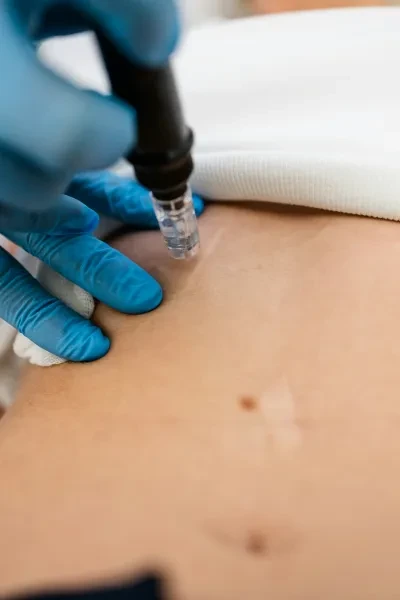FAQ
Dedicated space to answer all your questions about our treatments and services. You'll find clear, practical answers to guide you through your beauty and well-being journey.
PROCEDURAL FAQ
Paramedical tattooing, also known as medical tattooing or medical pigmentation, can be applied for various purposes. Scar camouflage significantly improves the appearance of individuals affected by skin conditions such as vitiligo or post-inflammatory hypo/hyperpigmentation caused by skin trauma. Additionally, scar camouflage helps reduce the visibility of scars caused by burns, accidents, and many other reasons.
After a mastectomy, reconstructive camouflage assists patients by recreating a nipple and areola on the newly reconstructed breast.
Aesthetic, artistic, and paramedical solutions help enhance the appearance of men and women experiencing physical irregularities due to the following conditions:
Scar Camouflage
- Scars from cosmetic surgery
- Breast lift (Mastopexy)
- Breast reconstruction (Mastectomy)
- Burns and injuries
Skin Depigmentation
- Pigment loss from scarring
- Vitiligo (skin depigmentation)
- Hypo/Hyperpigmentation of the areola
Areola or nipple micropigmentation involves tattooing the skin with various flesh-toned pigments to camouflage scars or areas of the skin that lack natural pigment. The goal is to conceal a scar or skin discoloration. This is a specialized area of permanent cosmetics and falls under the category of medical or paramedical tattooing.
This process is also known as Corrective Pigment Camouflage (CPC), corrective camouflage, skin repigmentation, scar camouflage, skin camouflage, camouflage tattooing, and skin color tattooing.
The specialist performing these procedures must have a deep understanding of pigment science, color theory, skin and human tissue physiology, and aseptic techniques. These procedures require advanced knowledge, training, skills, and an artistic eye.
Your scar must be at least 12 months old and have a stable color. If it is still red, pink, or changing color, the tissue may still be healing. A reputable and experienced medical tattoo artist will not work on scar tissue prematurely, as it could cause further skin damage.
(Note: If you were under a healthcare professional’s care for the condition, ask them if you are a candidate for areola micropigmentation treatment.)
Scar Quality:
Camouflage tattooing cannot mask or correct severe changes in skin texture.
(Note: If you have surface irregularities, please consult a dermatologist or surgeon first.)
What You Should Know About Scar Camouflage/Revision:
Camouflage tattooing will not restore your skin to its exact pre-injury appearance. It works as a visual illusion, making the area appear "perfect" again. It improves color differences to conceal the scar or irregularity and make it less noticeable to others. Therefore, it’s important to maintain realistic expectations. Be sure to discuss them thoroughly with your practitioner.
We offer a flat rate of $550 for complete areola pigmentation.
This includes the two essential steps required for your areola restorative pigmentation process:
- The initial procedure
- A touch-up session two months later
At your final appointment, you will be our guest—we have a special experience planned just for you.

PARAMEDICAL FAQ
Color: Your practitioner will assess your skin color at the beginning of each session and select a custom blended color to match your complexion.
Pigmentation: During the paramedical tattooing, the practitioner uses a needle that gently vibrates over the skin layers, depositing mineral-based pigment into the skin and blending it until the scar(s) are fully camouflaged and the skin tone matches.
Some swelling and/or redness is common. This gradually fades, and any slight swelling usually disappears within several days, depending largely on the area treated, the intensity of pigment application, and your skin’s overall health.
Right after your procedure, the color will appear darker or more intense than the final look. After a few days, the skin will gently exfoliate, and the color will fade to its intended shade.
It’s important to keep the treated area clean and moisturized using only the aftercare products we provide at no extra cost. Avoid applying any makeup on the treated skin for seven days after each session.
A minimum of two sessions is required. Plan for about three hours for the first appointment (file opening, pre- and post-treatment photos, consultation with our technician, and the micropigmentation treatment).
The second session is for touch-ups and a special moment with us. This second session is scheduled about 8 weeks later.
Although the pain is minimal, the level of discomfort varies from person to person depending on the area of the body being camouflaged. A topical anesthetic cream is used if needed.
The scar must be at least 12 months old and fully healed. There is no upper age limit for scars; we have camouflaged scars that are over 65 years old.
DermaSKa can camouflage all types of scars, including those from cosmetic or therapeutic surgeries. Different areas of the body have very different skin types and thicknesses. Every scar is unique and must be treated with care.
Arrive 30 minutes early to your appointment, well-rested and relaxed.
Color: Your practitioner will assess the color of your skin and areola at the beginning of each session and select a custom color or blend that suits you best.
Pigmentation: To perform the tattoo, the practitioner uses a single sterile needle that gently vibrates on the skin’s dermal layers, depositing a mineral-based pigment into the areola until the desired color is achieved.
Yes! DermaSKa camouflages scars around the areola, including those from mastectomies and other breast surgeries.
Yes! When you make them smaller, tattooing is also used to camouflage the outer edges with a skin tone that matches the surrounding skin.
Yes! It’s a simpler procedure than reducing them.
Yes! Detailed measurements are taken to achieve the symmetry you desire. Sometimes, a combination of enlarging certain areas and reducing others is used to create symmetry.
Yes! You can choose your color.

References
- Bondil, P., Habold, D. et Carnicelli, D. (2016). Cancer et sexualité : le couple, un déterminant trop souvent négligé, Sexologies, 25, 61-68.
- Borquiren V. M., Esplen M. J., Wong J., Toner B., Warner E., Noorulain M. (2016). Sexual functioning in breast cancer survivors experiencing body image disturbance. Psycho-Oncology, 25 (1). 66-76. DOI: 10.1002/pon.3819
- Cha H. G., Kwon J. G., Kim E. K. Lee. H. J. (2019). Tattoo-only nipple-areola complex reconstruction: Another option for plastic surgeons. Journal of Plastic, Reconstructive & Aesthetic Surgery, 1-7.
- Dizon, D. S. (2009). Quality of Life after Breast Cancer: Survivorship and Sexuality. Breast J., 15(5), 500-504.
- Emilee, G. et al. (2010). Sexuality after breast cancer: A review. Maturitas, 66, 397-407.
- Fang, S., Chang H., Shu B. (2014). Objectified Body Consciousness, Body Image Discomfort, and Depressive Symptoms Among Breast Cancer Survivors in Taiwan. Psychology of Women Quarterly, 38 (4). 563-574.
- Fortin, P. Charron, A. Beauchamp, J. Morin S et Lagacé J. (2010). Corps, femmes et féminité : Le vécu des jeunes femmes atteintes du cancer du sein au Nouveau-Brunswick. Recherches Féministes, 23(2), 71-219.
- Gilbert, E., Ussher, J.M. & Perz, J. (2010). Sexuality after breast cancer: A review. Maturitas, 66, 397-407.
- Henry, M, Baas, C., Mathelin, C. (2010). Reconstruction mammaire après cancer du sein : les motifs du refus. Gynécologie Obstétrique & Fertilité, 38, 217–223. doi:10.1016/j.gyobfe.2009.10.003
- Murphy A. D., Conroy F. J., Potter S. M., Solan J., Kelly J. L., Regan P. J. (2010). Patient satisfaction following nipple-areola complex reconstruction and dermal tattooing as an adjunct to autologous breast reconstruction. Eur J Plast Surg, 33. 29-33
- Taquet A. (2005). Cancer du sein et sexualité. Springer, 3, 170-274.